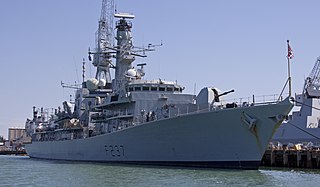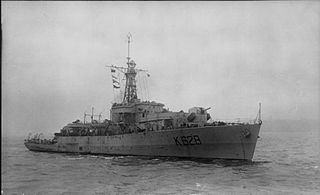
HMS Triumph is a Trafalgar-class nuclear submarine of the Royal Navy and was the seventh and final boat of her class. She is the nineteenth nuclear-powered hunter-killer submarine built for the Royal Navy. Triumph is the tenth vessel, and the second submarine to bear the name. The first HMS Triumph was a 68-gun galleon built in 1561. As of 2022, she is the last boat of her class remaining in service.

HMS Iron Duke is a Type 23 frigate of the Royal Navy, and the third ship to bear the name.

HMS Monmouth was the sixth "Duke"-class Type 23 frigate of the Royal Navy. She was the seventh ship to bear the name and was launched by Lady Eaton in 1991, being commissioned two years later.

HMS Westminster is a Type 23 frigate of the Royal Navy, and the second ship to bear the name. She was launched on 4 February 1992 and named for the Dukedom of Westminster.

HMS Northumberland is a Type 23 frigate of the Royal Navy. She is named after the Duke of Northumberland. She is the eighth RN ship to bear the name since the first 70-gun ship of the line in 1679, and the ninth in the class of Type 23 frigates. She is based at Devonport and is part of the Devonport Flotilla.

HMS Tireless was the third Trafalgar-class nuclear submarine of the Royal Navy. Tireless is the second submarine of the Royal Navy to bear this name. Launched in March 1984, Tireless was sponsored by Sue Squires, wife of Admiral 'Tubby' Squires, and commissioned in October 1985.

HMS Trenchant was a Trafalgar-class nuclear-powered fleet submarine of the Royal Navy built by Vickers Shipbuilding, Barrow-in-Furness. Trenchant was based at HMNB Devonport. She was the third vessel and the second submarine of the Royal Navy to be named for the characteristic of vigour and incisiveness.

HMS Loch Fada was the lead ship of the Loch-class frigates of the British Royal Navy, built by John Brown & Company of Clydebank, Scotland, and named after Loch Fada in the Inner Hebrides.

HMS Loch Killisport (K628/F628) was a Loch-class frigate of the British Royal Navy, named after Loch Killisport in Scotland. Launched in 1944, the ship was not commissioned until July 1945, and served in post-war repatriation operations in the Far East until decommissioned in April 1946. During this time Prince Philip was an officer on board this ship. Recommissioned in 1950 she served in the Home Fleet for two years, before being extensively modernised for service in the Persian Gulf and Far East. Decommissioned in August 1965, she was sold for scrapping in 1970.

HMS Bristol (D23) was a Type 82 destroyer, the only vessel of her class to be built for the Royal Navy. Bristol was intended to be the first of a class of large destroyers to escort the CVA-01 aircraft carriers projected to come into service in the early 1970s but the rest of the class and the CVA-01 carriers were cancelled as a result of the 1966 Defence White Paper which cut defence spending.

The seventh HMS Dreadnought was the United Kingdom's first nuclear-powered submarine, built by Vickers Armstrongs at Barrow-in-Furness. Launched by Queen Elizabeth II on Trafalgar Day 1960 and commissioned into service with the Royal Navy in April 1963, she continued in service until 1980. The submarine was powered by a S5W reactor, a design made available as a direct result of the 1958 US–UK Mutual Defence Agreement.

Standing Royal Navy deployments is a list of operations and commitments undertaken by the United Kingdom's Royal Navy on a worldwide basis. The following list details these commitments and deployments sorted by region and in alphabetical order. Routine deployments made by the Navy's nuclear-powered submarines and their location of operations is classified.

USS Whale (SSN-638) was a Sturgeon-class submarine nuclear-powered attack submarine of the United States Navy. She was the second ship of that name, after the whale family of aquatic mammals.

HMCS Corner Brook is a long-range hunter-killer submarine (SSK) of the Royal Canadian Navy. She is the former Royal Navy Upholder-class submarine HMS Ursula (S42), purchased from the British at the end of the Cold War. She is the third boat of the Victoria class and is named after the city of Corner Brook, Newfoundland. The submarine was launched in 1989 and entered service with the Royal Navy in 1992. The Royal Navy laid Ursula up in 1994. In 1998, Canada acquired the submarine from the United Kingdom. The vessel entered service with the Canadian Armed Forces in 2003. Renamed Corner Brook, the submarine took part in several military exercises both internationally, such as NATO exercises and domestic, such as Operation Nanook. In June 2011, the submarine ran aground in Nootka Sound, damaging the vessel's bow. The submarine was sent for refit in 2014 to complete the repairs.

HMS Rotherham was an R-class destroyer of the British Royal Navy during the Second World War, named after Captain Edward Rotheram, who commanded HMS Royal Sovereign during at the Battle of Trafalgar in 1805. Rotherham was completed in 1942 and equipped as a flotilla leader, having slightly reduced armament to allow for the increased complement and working space required. Decommissioned in 1945, the ship was sold to India in 1948, serving as INS Rajput (D141) until 1976, when she was scrapped.

HMS Cattistock, the third ship of this name, is a Hunt-class mine countermeasures vessel of the Royal Navy. She was launched in 1981 and commissioned on 5 March 1982, the third ship of her class.

The Shoreham-class sloops were a class of eight warships of the Royal Navy built in the early 1930s.

HMS Narwhal (S03) was a Porpoise-class submarine of the Royal Navy. She was launched on 25 October 1957.

HMS Bonaventure was a submarine depot ship of the Royal Navy. She was initially built for civilian service with the Clan Line, but on the outbreak of the Second World War she was requisitioned by the Navy and after being launched, was converted for military service.



















